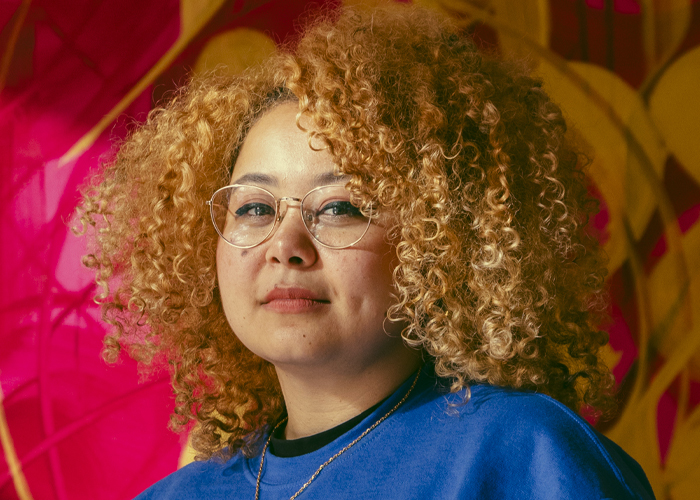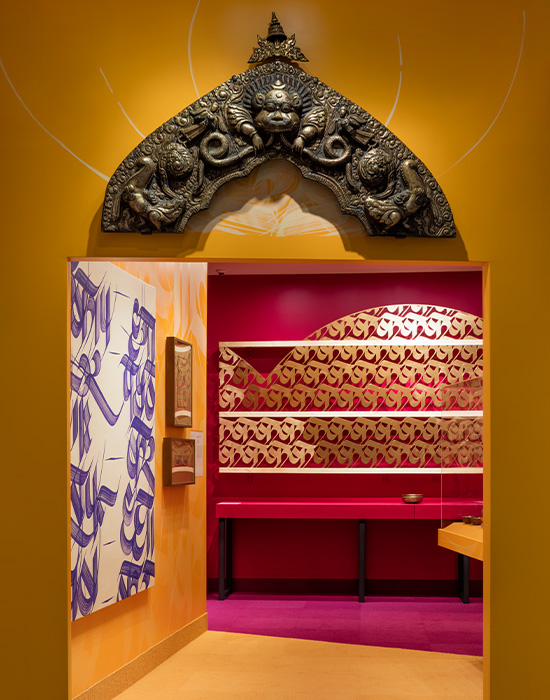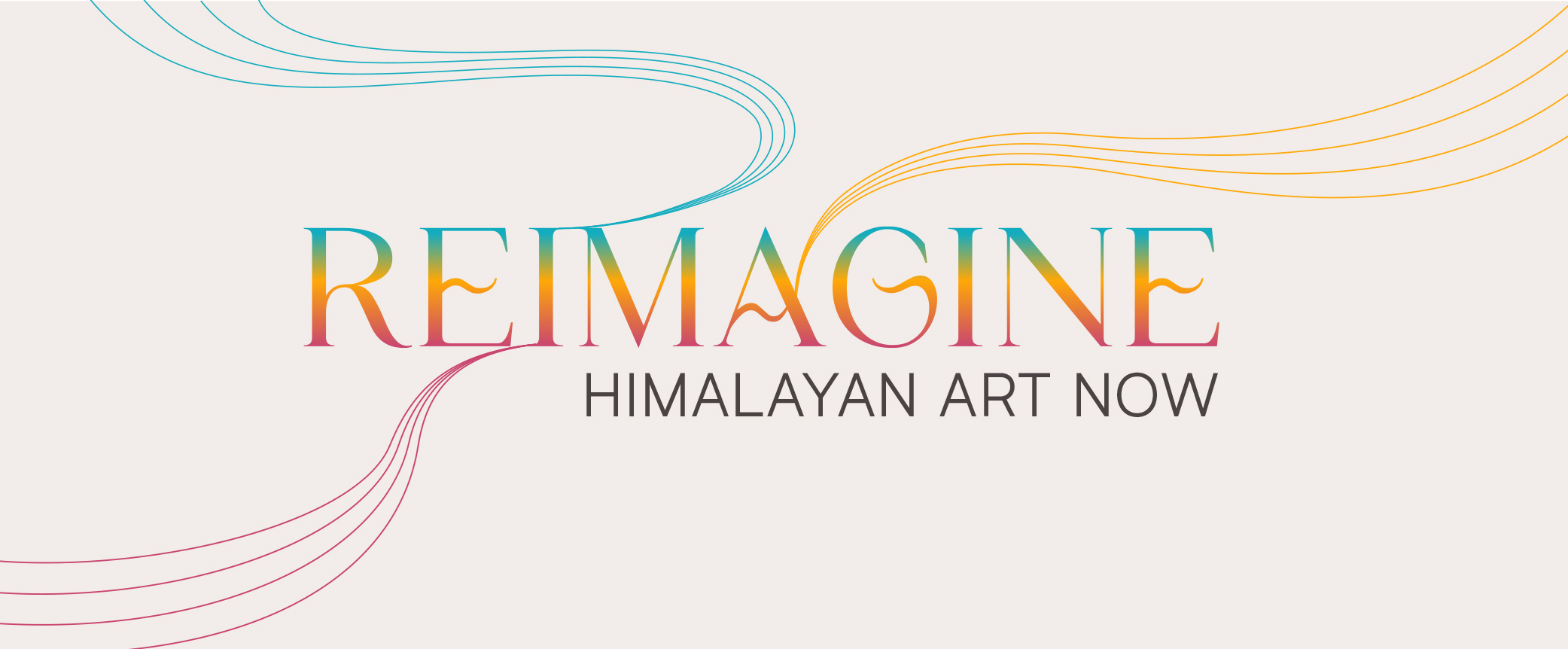
IMAGINE (a.k.a. Sneha Shrestha)
Reimagine: Himalayan Art Now
March 15–October 6, 2024

LISTEN TO THE ARTIST
ABOUT THE ARTIST
IMAGINE (a.k.a. Sneha Shrestha) (she/her)
b. 1987, Kathmandu, Nepal; lives in Boston, MA; works in Kathmandu, Nepal, and Boston, MA
IMAGINE (a.k.a. Sneha Shrestha) is a Nepalese artist who incorporates her native language and meshes the aesthetics of Sanskrit scriptures with graffiti influences. She has shown her meditative works in several exhibitions, commissioned works and public walls around the world, from Kathmandu to Boston.
IMAGINE’s painting Home416 was recently acquired into the permanent collection of Museum of Fine Arts, Boston, making her the first contemporary Nepalese artist to ever be acquired in the history of the MFA. Her first major solo show Sneha Shrestha: Ritual and Devotion is on view at the Cantor Art Gallery at the Prior Arts Center.
She has shown work at the Isabella Stewart Gardner Museum and the Museum of Fine Arts, Boston. She was recognized by WBUR as one of the 25 millennial artists of color impacting Boston and recognized as Outstanding Artist of the Year by the Center for Arts at the Armory. IMAGINE’s work is held in the private collections of Facebook, Google, and Fidelity Investments. She received her master’s from Harvard University, is an educator and social entrepreneur. She passionately supports Asian art by working as the arts program manager at the South Asia Institute at Harvard.
imagine876.com / @imagine876
ABOUT THE ARTWORKS IN REIMAGINE
IMAGINE has created artworks inspired by the Rubin Museum’s collection for Reimagine—Mending and Moving installation and The Menu.
Mending and Moving

This immersive installation is inspired by the artist’s experience viewing Nepalese ritual objects in US museums, and is divided into three parts: a portal, yellow ritual implement hall, and pink meditative room. Visitors walk through the portal crowned with a Nepalese torana from the Rubin’s collection. Such torana typically appear at the entrance to temples in Nepal. This torana is missing its central panel, which IMAGINE (a.k.a. Sneha Shrestha) replaced or “mended” with a panel of script.
In the yellow hall, the artist juxtaposed objects from the Rubin with objects from her family home in Nepal. In contrast with the pristine Museum objects, her family’s pieces still display the puja powders and other organic materials used in daily ritual. The artist questions if visitors can tell the difference between living objects—ones currently used in ritual—and those whose spiritual nature is not present, as they are Museum objects not in ritual use.
In the pink room, the artist reimagines how museums could celebrate cultures “by celebrating the voices and visuals of people of the culture and by people of the culture.” The gold sculpture Calling the Earth to Witness transforms the area into a welcoming space for everyone. The flowers on the contemporary altar represent the living nature of Newari rituals built into everyday life and thus kept alive. The artist encourages visitors to immerse themselves in the space and find a calm, sacred place within themselves, as a respite from our rapidly changing world full of uncertainties.
Objects in the Yellow Room
“In this area of the room, I am recreating my feelings when I see Nepalese ritual objects in museums. First, the feeling is that of familiarity and excitement upon recognizing the objects, and then slowly despair as my mind gets flooded with images of what looks like those same objects in my Kathmandu home, covered in tika, rice, flowers, soot, and oil. I wonder if the spiritual nature of these museum objects lives on? What happens when ritual objects aren’t used for rituals? Then are they still ritual objects?” —IMAGINE (a.k.a. Sneha Shrestha)
The artist does not wish to distinguish between Museum objects and her personal ritual objects, so in the installation there are no typical wall labels for objects from the Rubin’s collection.
RELATED RUBIN OBJECT

The inclusion of this object from the Rubin Museum’s collection in Mending and Moving reflects the artist’s commentary on the fact that most Nepali manuscripts in Western museums are overlooked and remain untranslated.
The Menu
IMAGINE (a.k.a. Sneha Shrestha) came across the manuscript page seen next to this painting in the installation (see image above) when visiting the Rubin’s collection storage. On the back of a drawing of a bodhisattva figure, the vertical orientation of the letters piqued her curiosity. Manuscripts typically have a horizontal orientation, such as the Manuscript Folio with Buddha Ratnasambhava from the Rubin Museum shown below. The long horizontal lines reminded her of a list, and upon closer inspection, she found the names of a few foods in Nepali.
“My first thought was is this some kind of a menu?” she recalls. “At the moment, nobody knows because it remains untranslated. This is why I titled my painting The Menu, as absurd as it sounds. Now that I’ve thought about it more, it could maybe be a list of items needed to complete a ritual.”
RELATED RUBIN OBJECT

This manuscript page from the Rubin Museum’s collection inspired IMAGINE’s painting The Menu in the Reimagine exhibition, inviting new ways of encountering traditional Himalayan Art.


